The concept is very old. Preparation and design take a lot of time, energy and cost. Construction too. The impact on nature is huge. How does the old design perform in modern times? Does it have a future at all?
PROLOGUE
SAFE
This is the (Old) Bidwell Bar Bridge at Lake Oroville, California.
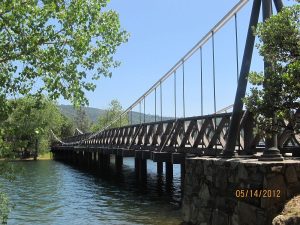
It was the first steel suspension bridge in California, completed in December 1855. It is unbelievable but true that the materials for the bridge were transported from Troy, New York, via Cape Horn (!). (The construction of the Panama Canal was finished later, only in 1914.)
The bridge originally crossed the Middle Fork Feather River, but because of the construction of the Oroville Dam preservationists relocated the bridge in 1966 to the south side of the lake, where it is still open to foot traffic. The bridge is registered as a California Historical Landmark and the relocation secured it’s safety.
UNSAFE
This the Mother Orange Tree, the oldest living orange tree in Northern California.
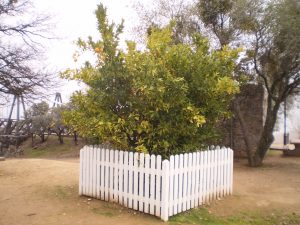
Originally planted in Bidwell’s Bar near the Bidwell Bar Bridge, the tree is a Mediterranean sweet orange Citrus × sinensiscultivar. The citrus rootstock was brought from Mazatlán, Mexico. As the years passed the tree reached a height of over 60 feet (18 m) and yielded a yearly average of 600 pounds (273 kg) of oranges.
The tree has been transplanted twice: the second one happened in 1964 during the construction of Oroville Dam when it was moved to the California State Park Headquarters in Oroville.
Even after the second relocation the tree’s actual position is downstream of the dam and an incident at the Oroville Dam may flood the whole area.
CATASTROPHIC
This is the Oroville Dam.
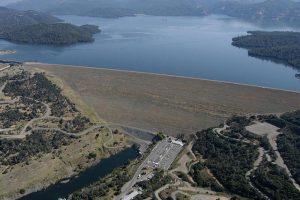
With its 770 feet (235 m) height, it is the tallest dam in the U.S. and serves mainly for water supply, hydroelectricity generation (pumped-up hydro facility for electricity generation) and flood control. The dam impounds Lake Oroville, the second largest man-made lake in California, capable of storing more than 3.5 million acre-feet (4.4 km3) water.
Which are the endangered settlements potentially threatend by an incident at the Oroville Dam?
You may think of the nearest county.
Right, plus the neighbouring county.
And another county too.
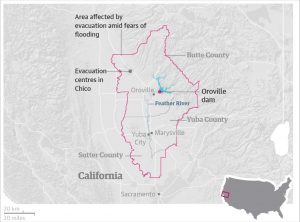
If the Oroville Dam broke, it would force the evacuation of these counties, close to 200,000 people downstream along the Feather river.
THE INCIDENT
At the end of one of California’s worst droughts on record, Northern California saw its wettest winter in almost a century in the first half of 2017.
Many parts of the state were unprepared to handle the huge volume of rain and snow.
As storms dumped significant precipitation on the area, the water level in Lake Oroville rose dramatically. It seemed that the main spillway of the dam was able to deal with the huge amount of water, but signs of damage began to appear on February 7. The main spillway’s lower part showed strange behaviour generating odd turbulences along the chute.
The management tried to assess the extent of damage so closed down the main spillway. The water level of the lake was rising further and the water began to flow over a concrete weir at the top of the dam’s emergency spillway. Unfortunately the emergency spillway had never been tested before… and the potential danger of headward erosion of the emergency spillway threatened the communitinities downstream with a 30-foot (9 m) wall of water.
So, despite the serious damage of the lower part of the main spillway the management decided on the reopening of it. A collapse never occurred, but the main spillway suffered significant damage…
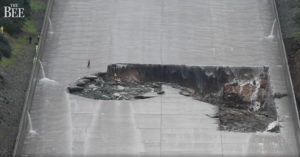
and the bare slope of the emergency spillway was significantly eroded.
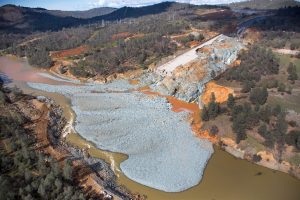
The emergency situation prompted the evacuation of more than 180,000 people living downstream along the Feather River.
PRESENT
What does this tragedy teach us? Let’s hear the thoughts of Stanford dam expert Martin McCann, Jr., on May 09, 2017 (www.newsdeeply.com):
„At the end of the day a lot of these things take time and money and thought to make them happen, money being the big one. And the dam industry, by and large, typically does not want to spend money. Which translates more broadly into, I think that they are undervaluing the asset, and the value of the asset to society. Everybody needs water, and power, and at least some of that is going to come from dams. So we don’t invest in research, we don’t invest in improved technologies, we don’t invest in improved practices and we don’t invest in training enough people to use the practices that we have.”
Has the development of new dam projects stopped? Of course not. The new projects are developed however in other regions.
Where are the significant developments?
Asia and South-America and… Africa. Here are some examples.
The Argentine government’s energy and environment ministries will move forward with construction of the 1,740-MW hydro complex on the Santa Cruz River in Santa Cruz province, Argentina.
Chinese conglomerate Sinohydro has been awarded a contract by the Bolivian Ministry of Energy to construct the 280-MW Iviriu hydropower plant in the South American country.
Sarawak state-owned electricity utility, Sarawak Energy Berhad (SEB), announced it has completed its acquisition of the 2,400-MW Bakun hydropower project, the country’s largest project, located on the island of Boreneo in Sarawak, Malaysia.
The Grand Ethiopian Renaissance Dam project is located approximately 500 km north west of the capital Addis Ababa, along the Blue Nile. At the end of the works, the Grand Ethiopian Renaissance Dam will be the largest dam in Africa: 1,800 m long, 155 m high and with a total volume of 74,000 million m³.
The project involves 2 power stations, with a total installed power of 6,000 MW and estimated production of 15,000 GWh per year.
FUTURE
Does the technology have a future in the U.S.? Or does the state of the existing dams pose enough threat and challenge to tackle? According to some of the publicly available documents 15,498 dams are identified as highly hazardous in the States. That is 17% of the existing dams. The tendency is even more shocking, the increase in number of high-hazard dams from 2005 is 50%.
45 billion USD is needed at least to repair the most dangerous dams in the U.S.
Will Trump administration allocate the resources required?
It does not seem that Trump is inclined to set this issue as priority… war presidents are more popular.

Leave a Reply